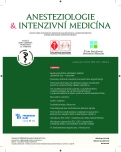-
Medical journals
- Career
Effect of combination of prone position and high-frequency oscillatory ventilation on blood gas exchange in experimental model of acute respiratory distress syndrome
Authors: Žurek Jiří; Košut Petr; Dominik Petr; Šeda Miroslav; Klimovič Michal; Fedora Michal
Authors‘ workplace: Klinika dětské anesteziologie a resuscitace LF MU a FN Brno
Published in: Anest. intenziv. Med., 24, 2013, č. 1, s. 33-39
Category: Intensive Care Medicine - Original Paper
Overview
Objective:
The aim of the study was verification of the effect of combination of high-frequency oscillatory ventilation and prone position in an experimental model of acute respiratory distress syndrome.Design:
Experimental study. Setting: Department of Anaesthesiology and Intensive Care Medicine, University Hospital.Materials and Methods:
The study included 40 experimental piglets. Lung damage was induced by repeated bilateral lung lavage with saline to achieve PaO2/FiO2 < 100 mm Hg. The experimental animals were randomized into 5 groups - control group (PCV in supine position throughout the experiment), PP (PCV in prone position and then in supine position), HFOV (HFOV in supine position throughout the experiment), HFOV + PP (HFOV in supine position, after 6 hours of prone position and then supine position), PP + HFOV (PCV in prone position, after 6 hours HFOV, further rotation of supine and prone positions, as the PP group).Results:
In terms of oxygenation (PaO2) there was no difference between the PP and HFOV groups, higher values of PaO2 were achieved in the PP+HFOV group than in the HFOV+PP group. CO2 elimination was better in the HFOV+PP group than in the PP+HFOV group. There was no difference between the PP and HFOV groups. There was no difference in oxygenation index between the PP and HFOV groups, the PP+HFOV group had a lower oxygenation index than the HFOV + PP group.Conclusion:
There were no differences in oxygenation and CO2 elimination between the prone position and high-frequency oscillation groups. The combination of PP + HFOV is more efficient in terms of oxygenation.Keywords:
acute respiratory distress syndrome – experiment – oxygenation – ventilation – prone position – HFO
Sources
1. HiFO Study Group: Randomized study of high-frequency oscillatory ventilation in infants with severe respiratory distress syndrome. J. Pediatr., 1993, 122, p. 609–619.
2. Clark, R. H., Gerstmann, D. R., Null, D. M. et al. Prospective Randomized Comparison of High-Frequency Oscillatory and Conventional Ventilation in Respiratory Distress Syndrome. Pediatrics, 1992, 89, 1, p. 5–12.
3. Gerstmann, D. R., Minton, S. D., Stoddard, R. A. et al. The Provo multicenter early high frequency oscillatory ventilation trial: improved pulmonary and clinical outcome in respiratory distress syndrome. Pediatrics, 1996, 98, p. 1044–1057.
4. Arnold, J. H., Hanson, J. H., Toro-Figuero, L. O. et al. Prospective, randomized comparison of high-frequency oscillatory ventilation and conventional mechanical ventilation in pediatric respiratory failure. Crit. Care Med., 1994, 22, 10, p. 1530–1539.
5. Fort, P., Farmer, C., Westerman, J. et al. High-frequency oscillatory ventilation for adult respiratory distress syndrome – a pilot study. Crit. Care Med., 1997, 25, p. 937–947.
6. Derdak, S. High-frequency oscillatory ventilation for adult acute respiratory distress syndrome: A decade of progress. Crit. Care Med., 2005, 33, 3, p. S113–S114.
7. Abroug, F., Ouanes-Besbes, L., Elatrous, S. et al. The effect of prone positioning in acute respiratory distress syndrome or acute lung injury: a meta-analysis. Areas of uncertainty and recommendations for research. Intensive Care Med., 2008, 34, p. 1002–1011.
8. Gattinoni, L., Protti, A. Ventilation in the prone position: for some but not for all? CMAJ, 2008, 178, p. 1174–1176.
9. Papazian, L., Gainnier, M., Marin, V. et al. Comparison of prone positioning and high-frequency oscillatory ventilation in patients with acute respiratory distress syndrome. Crit. Care Med., 2005, 33, p. 2162–2171.,
10. Demory, D., Michelet, P., Arna, J. M. et al. High-frequency oscillatory ventilation following prone positioning prevents a further impairment in oxygenation. Crit. Care Med., 2007, 35, p. 106–111.
11. Brederlau, J., Muellenbach, R., Kredel, M. et al. High frequency oscillatory ventilation and prone positioning in a porcine model of lavage-induced acute lung Indry. BMC Anesthesiology, 2006, 6, 4, doi:10,1186/1471-2253-6-4.
Labels
Anaesthesiology, Resuscitation and Inten Intensive Care Medicine
Article was published inAnaesthesiology and Intensive Care Medicine

2013 Issue 1-
All articles in this issue
- Journal Anaesthesia and Intensive Medicine – new face again: This time not only a facelift
- Unusual cause of difficult airway – case report
- Current view of anaesthesia for carotid surgery
- Contribution of brain dormancy to clinical signs of brain damage and the possibility of its treatment by zolpidem
- Effect of combination of prone position and high-frequency oscillatory ventilation on blood gas exchange in experimental model of acute respiratory distress syndrome
- Bouveret syndrome
- Lyell syndrome
- Physical principles of ultrasound
-
2012 focused update of the ESC Guidelines for the managementof atrial fibrillation
An update of the 2010 ESC Guidelines for the managementof atrial fibrillation -
ESC Guidelines for the diagnosis and treatment of acute and chronic heart failure 2012
The Task Force for the Diagnosis and Treatment of Acuteand Chronic Heart Failure 2012of the European Society of Cardiology - 14th Cardiac Anaesthesia Days
- Anaesthesiology and Intensive Care Medicine
- Journal archive
- Current issue
- Online only
- About the journal
Most read in this issue- Physical principles of ultrasound
- Current view of anaesthesia for carotid surgery
- Bouveret syndrome
- Effect of combination of prone position and high-frequency oscillatory ventilation on blood gas exchange in experimental model of acute respiratory distress syndrome
Login#ADS_BOTTOM_SCRIPTS#Forgotten passwordEnter the email address that you registered with. We will send you instructions on how to set a new password.
- Career

